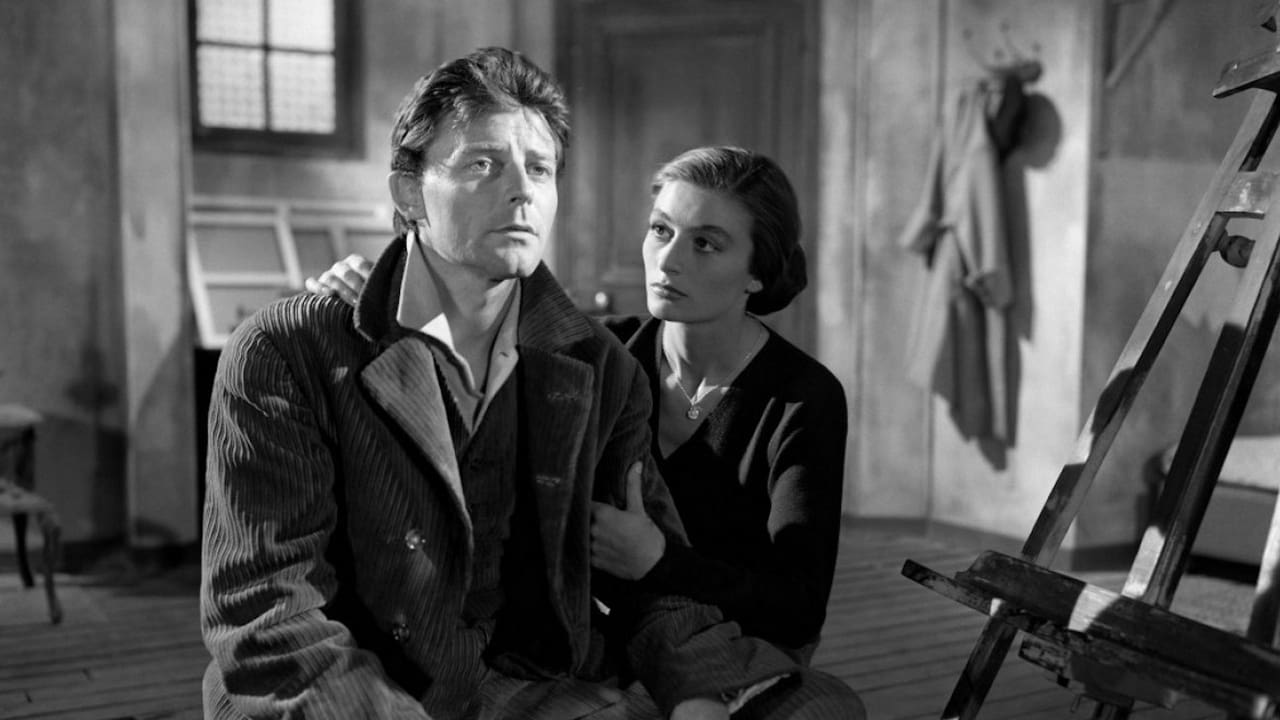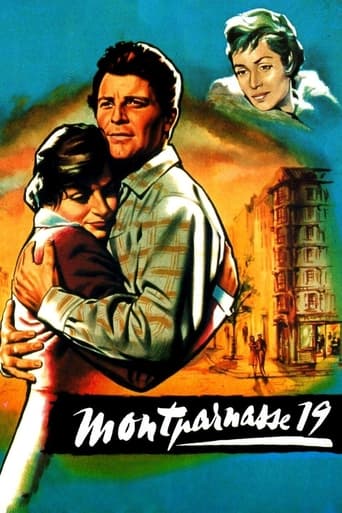Sexyloutak
Absolutely the worst movie.
Voxitype
Good films always raise compelling questions, whether the format is fiction or documentary fact.
Humaira Grant
It’s not bad or unwatchable but despite the amplitude of the spectacle, the end result is underwhelming.
Staci Frederick
Blistering performances.
Benedito Dias Rodrigues
The last years of Modigliani's life in Paris 1919,this famous italian-french painter not match with greatest like Cezanne and Van Gogh but their paintings are so expensives nowadays which put him at high ground,the movie cover a few last years,he already condemned to die due the alcoolism,stayed some time in Nice near the sea to try to recover,back in Paris died still young 36 years old,sad end to true genius,neglected by many,today is honored...but too late!!!Great casting Lili Palmer.Anouk Aimée,Lino Ventura and Gérard Philipe as Modigliani.Resume:First watch: 2018 / How many: 1 / Source: DVD / Rating: 8.25
Richard Chatten
The Grim Reaper casts a long shadow over this film depicting the final declining months of Amedeo Modigliani - one of the giants of 20th Century art - who in January 1920 died in Paris in poverty of tubercular meningitis aged just 35. The original director Max Ophuls had died suddenly at the age of 54, and both his replacement as director and the film's star were dead within two years of its completion.Had Ophuls lived we would now be contemplating a very different film - probably in colour and alive with his trademark dolly shots. Having already shown the seamier side of the Belle Époque in 'Casque d'Or', Jacques Becker wasn't about to romanticise Parisian life after The Great War. In addition to making drastic changes to Henri Jeanson's script - which led to rows - Becker (who had just made his two worst films, both in colour, which put him off making a third), instead of lifting the soul by concentrating on the art as posterity's triumph over the life, as had 'Lust for Life', takes us on a bleak, monochromatic tour of the lower depths of Modigliani's cramped and thwarted mortal existence; his mental and physical decline reflected in Paul Misraki's sinister score.The film already carries an on-screen disclaimer that it takes liberties with historical fact; and good as they both are as the two doomed lovers, it's hard to believe the ethereal Gerard Philipe as the sort of brute who could possibly strike a woman, while Anouk Aimee looks more like a chic fifties left bank existentialist than a vulnerable little waif. A vibrant Lili Palmer, however, is spot on as Modigliani's bohemian ex-lover. Representing the art trade, Lino Ventura looks as if he's barged in from the set of 'Touchez Pas au Grisbi'; and the final shot of him greedily rifling through Modigliani's artistic legacy is not for the faint-hearted.
hasosch
I am convinced that only those people can really appreciate this movie whose title is either "Modigliani", "Les Amants De Montparnasse" or "Montparnasse 19", who are aware that the last year of life of the Italian-French painter Amedeo Modigliani (1884-1920) who died with 36 years, was played by Gérard Philipe, who was lethally sick during the shooting of this movie and died shortly after its release, 1959, with 36 years - on one of the two diseases that Modigliano had himself and exactly in his age. Further, this movie was directed by Jacques Becker - after the sudden death of Max Ophüls. Becker, too, died only 2 years after this movie. Since it is clear that Philipe knew that his days were counted and since one can assume that also Becker knew about his own few remaining months, this movie, suddenly, does not look like kitsch anymore. I just would like to mention that famous scene, where "Modi" says: "Jeanne, on the other side, there will be eternal joy, isn't that so, Jeanne?". Philipe's tears are probably real. In another famous scene, where Modi is going to be humiliated by an American billionaire, he quotes Van Gogh: "I have to drink a lot to get that splendid yellow back that I found last summer". These words could be Philipe's own words. Fassbinder who dedicated his movie "Despair" amongst two others to Van Gogh called this phenomenon "A Trip Into The Light".It is a famous as well as sad fact that his contemporaries put as many obstacles as they could in the way of Jacques Becker, so that he was able to realize only a good dozen of movies. Today, half a century after Becker's death, "Modigliani" is still not available. The only American VHS edition is long out of print, and one pays horrendous prices for a copy. And the worst: not even in France, this film is available, neither as VHS nor DVD. So you must go through a lot pain, if you want to watch this masterpiece. But it is worth, I assure you.
fordraff
This is a boring, clichéd film about a drunken, drug-addicted artist and several women with whom he was involved during the last year of his life in Paris.I'd seen this all before. The artist and his mistress live in a garret with a charming view of Nice out of their windows. But they are starving and must depend on the kindness of friends for their food or on the little money the wife can make painting postcards. The artist is tormented by his own failings--here primarily alcohol, though a reference is made to opium use--and his failure to sell his paintings to a public who doesn't understand his work. The artist is involved with several women, all of whom he treats badly, and with greedy art dealers who treat him badly.The artist here is Modigliani, who is a physically sick man throughout the film. There is any number of scenes in which Gérard Philipe's face is sweating with the very exertion of staying alive. Yet the film never offers any background on how Modigliani came to this point or background on any of the characters or situations in this film.And what, exactly, was Modigliani's relationship to the three women he's shown with? Bèatrice Hastings appears to be a wealthy woman who supplies Modigliani with opium and liquor. He physically abuses her, which she treats lightly, which doesn't go down very well today.Rosalie owns a restaurant and bar where Modigliani tries to con drinks based on his charm and Rosalie's lingering affection for him.And then there is Jeanne Hébuterne, whom the subtitles of the video identified as his wife. Apparently, in reality, she was just his mistress. As shown here, Jeanne was the sweet, virginal daughter of an upper-class family; her father strongly disapproved of her connection with Modigliani and locked her in her room to prevent her leaving their house to live with him. Then a few scenes later, Jeanne is free of her parents and meeting Modigliani in Nice. What happened in the interval? Some scenes edited out? The best scene in the film, the one point where the film comes alive, shows Modigliani, Jeanne, and his friend Léopold Sborowsky in the hotel suite of Mr. Dickson, an American industrialist who is interested to purchase some of his paintings. But Mrs. Dickson has no interest in her husband's deal, only in getting him packed and out of the hotel in time to meet the boat train. Finally, she bustles Dickson out before he can make a purchase.A touching scene shows a sickly Modigliani moving about the terrace of La Coupole trying to sell for five francs his drawings to the uninterested patrons. But this sort of scene is one we've seen in other films about starving artists.Gérard Philipe certainly had the handsomeness to play the doomed romantic hero and conveyed well the sick Modigliani here. But I've concluded that Gérard Philipe appeared mostly in mediocre films during his brief career.Both Anouk Aimée (Jeanne) and Lili Palmer (Bèatrice) are wasted in this film. Lila Kedrova has a small role as Mme. Sborowsky.But Lino Ventura most impressed me as Morel, the greedy, dastardly art deal. Marcel hovers over Modigliani like the angel of death, waiting for Modigliani to die for he knows that as soon as Modigliani is dead, his paintings will be worth something.This film has a troubled history, which may account for the poor final product. The film began as a Max Ophuls production. But when Ophuls died, he was still working on the film's script with Jenri Jeanson. According to Konstantin Bazarov's article on Becker in World Film Directors, Volume 1, "When Jacques Becker took over, he rewrote the script completely, provoking a violent quarrel with Jeanson." Modigliani's daughter also exerted her influence on the film. In a review in the May 1958 issue of Cahiers du Cinéma, Jean-Luc Godard defended "Montparnasse '19" as a film about the fear of making a film. I found the review--filled with double talk--as boring as most of Godard's films. Truffaut has an entire chapter on Becker in The Films of My Life in which he mentions "Montparnasse '19" intermittently.But the film must stand on its own; and it fails when it does that. It is a depressing film presenting a clichéd portrait of a dying artist in a story without narrative thrust and two-dimensional characters who never involve viewers. It's hard for me to believe that this film came from the same director who made the brilliant "Casque d'Or" and "Touchez Pas au Grisbi." Recommended to die-hard Philipe fans only.

